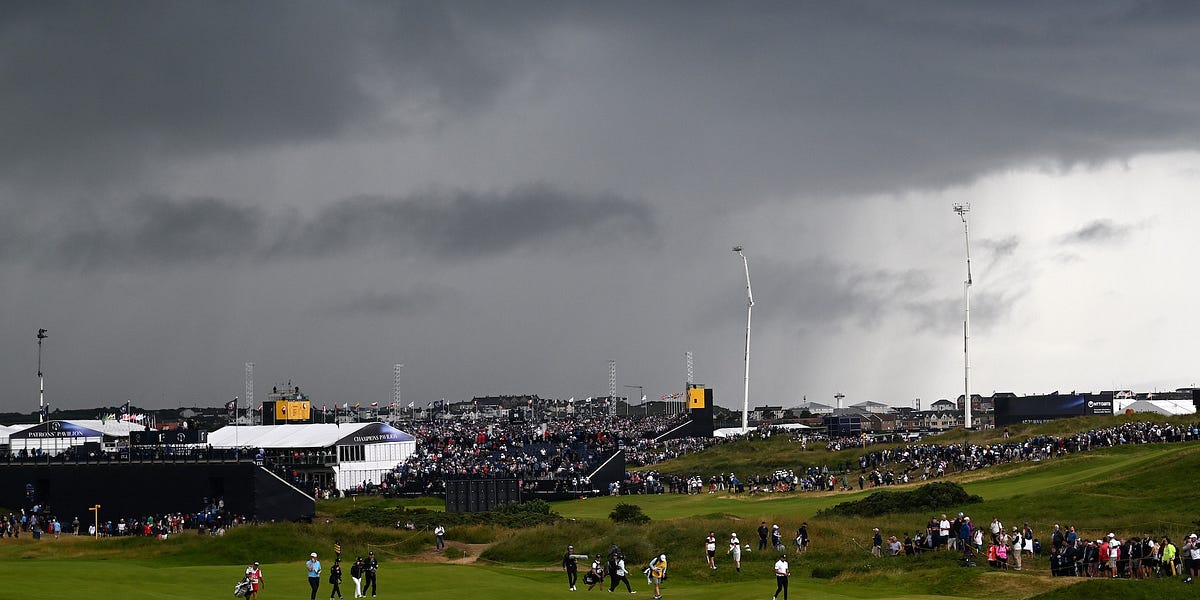 One of day two’s storms that was predicted by forecasters who struggled to commit all week. (Cameron Smith/R&A/R&A via Getty Images)
One of day two’s storms that was predicted by forecasters who struggled to commit all week. (Cameron Smith/R&A/R&A via Getty Images)
The headscratchers and forgettable moments that gave us something to talk about. (Champions and Cutmakers are already in the books.)
Eliminating The Rakers. Little traditions mean more to The Open than any other championship. Or, it’s at least a first-place tie with The Masters. The yellow scoreboards. Teeing off from the first tee (only). Where the announcer sounds like he’s been goosed midway through a player’s name. And until this year, the practice of a certified BIGGA greenkeeper following along with each group to rake bunkers ended after a decades-long run. The practice helped keep play moving just a bit faster because Open courses—I can’t believe I’m having to explain this—feature pot bunkers in fairways where the golfer usually blasts out only a short distance. The player is then quick to their ball. The rakers used to come in while the caddie moved on with their player. Not this year. The tradition was also a nice nod to the hardest-working and earliest risers in golf. None of the excuses for jettisoning this tradition passed the smell test. The mob scene inside the ropes remained just that. Play did not get faster. Caddies did not get paid better because they were back to raking. The whole thing is silly.
 Bunker raker Sean Tully at the 2019 Open in Portrush
Bunker raker Sean Tully at the 2019 Open in Portrush
Weather Predictions. The struggle to offer a working advanced forecast in Portrush seems particularly acute given the incredible accuracy of weather forecasters around the world. “I’d love to be a weatherman here,” Jason Day said with a smile. “You just get it wrong all the time.” This was after he’d been drenched by rain, which, to be fair, had been predicted as a possibility. “It’s not good to be wrong in golf. It might be good to be wrong as a weatherman.” Everyone understands that this is a tough place to predict the weather—just look at Sunday’s final round under bright skies and warm temperatures that were supposed to be 61 degrees with some heavy rain mixed in—but it’s the unwillingness to commit that had players and Americans spoiled by precise models. It was enjoyable to see players mock the forecasts only to have their words reported as references to the volatility of the weather, not the actual unwillingness to predict.

Boundary Lines. You didn’t think they’d get better, did you? By the tournament days, the painted lines had faded due to foot traffic on the 18th, only highlighting the graffiti-like silliness of it all. Since the club seems to be in love with something so beneath a place of its stature, here’s another angle to consider: Portrush’s first and 18th holes are as good as any opener and closer on the rota. Starts and finishes are often the least interesting design pieces on links. Not here. The first and last holes need no assistance from white stakes and paint. It’s like they’re wearing band-aids on non-existent wounds. Meanwhile, we get the safety issues out by the cliffs behind the fifth green. But the club also has one of the best short par-4s in golf it is junked up by the sheer volume of stakes vandalizing up the skyline green effect.
 Scheffler tees off on the 10th hole during (Stuart Franklin/R&A/R&A via Getty Images)
Scheffler tees off on the 10th hole during (Stuart Franklin/R&A/R&A via Getty Images)
Signage on Tees. They aren’t going away. We get it. But given the effort put into freshening up grandstands and other Open branding to give off a more sophisticated aura, the garrish onslaught of commercialization gives the impression that two different organizations are responsible for signage. The worst part? On several tees, these billboards eliminate key spectating opportunities to watch players in The Open where many tees are placed atop dunes and fans are below the players. At some point, something’s gotta give: either prioritize corporate partnerships or ticket sales. Trying to do both is failing the people who paid to see golf shots.
 12th hole stream at Royal Portrush
12th hole stream at Royal Portrush
12th. No matter the wind direction, the last three-shotter coming in was a total pushover. Yes, the hole yielded what was arguably the iconic shot of the championship when Rory McIlroy sank a long putt. The 532-yarder was such an unintimidating presence that players failing to make birdie felt like they were falling behind the field. Actually, that’s kind of fun in an ebb-and-flow, psychological gamesmanship way. The 12th played to a 4.509 average, gave up 219 birdies to 182 pars, and played 222-under-par for the week. As with the last Open at Portrush, the question remains: why is a natural waterway in front of the green piped and covered by fairway? Surely the stout members of Royal Portrush could handle playing a shot over a wee trickling stream?
NBC. Americans watching the telecast came away with the sense that Portrush was a lifeless affair. That certainly wasn’t the feeling on the ground and the reaction can be attributed to the network relying solely on the world feed without supplementing its shows with extra microphones, cameras, and course graphics that elevate a modern broadcast. It’s a particularly sad situations since NBC won The Open rights (starting in 2016) by selling the R&A on its then gold standard combination of coverage, marketing reach and love of the game. Then the network got off to a wonderful start in 2016 and dreams of NBC’s “Breakfast At Wimbledon” success seemed within reach. Then Arnold Palmer died and the Comcast slashing began, first to Golf Channel and now the network. With NBC having the Olympics, Super Bowl and year one of its overpriced NBA package net year, do not expect things to get better. Trusted voices like Mike Tirico and Terry Gannon will be key cogs in the NBA coverage. The future is also uncertain for the linear cable channel spinoff effort called Versant, which the Open broadcasts tackily pointed each day was now stitched on Rory McIlroy’s golf bag as part of his long-running GolfNow ambassadorship. What “value add” for the viewers. The whole thing is a shame for the American fans of the Open and the R&A, who took less money believing NBC could be trusted to care.
Kevin Kisner. Lead analyst duties call for hot takes and there will be misfires. But his comments on the Wyndham Clark situation—suggesting anything not kept private in a locker room is a violation of the precious players’ privilege of doing what? Damage? Forgetting to tip? Passing gas that forces an evacuation? Or whatever it is Kisner thinks is kosher behind closed doors. He point-missed on the notion of a player’s responsibility to be a good guest at a great place. Sadly, he’s delivering just the kind of forgettable, d-bro friendly, player-apologist nonsense that makes for awful television and seems to be what player-run TOURs demand. The good news? Kisner’s a Ryder Cup Vice Captain and won’t be able to offer vapid takes during September’s matches. Since Kisner blamed the USGA for somehow being to blame for leaking a photo of the locker damage induced by Clark, maybe “Kiz” should stay in the locker room and out of the announce booth.

Taylormade. After driver failures of their two highest profile active players at the PGA, you’d think the company might be more careful with details. Photoshopping in some carpet onto the Champion Golfer’s head made it look like Scheffler donned one of Sinatra’s old divots. Good grief.







